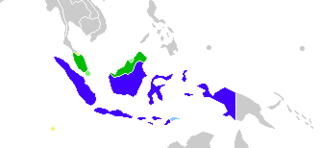Malay (/məˈleɪ/ mə-LAY;[9] Malay: Bahasa Melayu, Jawi: بهاس ملايو) is an Austronesian language that is an official language of Brunei, Indonesia, Malaysia, and Singapore, and that is also spoken in East Timor and parts of Thailand. Altogether, it is spoken by 290 million people (around 260 million in Indonesia alone in its own literary standard named "Indonesian") across Maritime Southeast Asia.[10][11]
The language is pluricentric and a macrolanguage, i.e., several varieties of it are standardized as the national language (bahasa kebangsaan or bahasa nasional) of several nation states with various official names: in Malaysia, it is designated as either Bahasa Malaysia ("Malaysian") or also Bahasa Melayu ("Malay language"); in Singapore and Brunei, it is called Bahasa Melayu ("Malay language"); in Indonesia, an autonomous normative variety called Bahasa Indonesia ("Indonesian language") is designated the bahasa persatuan/pemersatu ("unifying language" or lingua franca) whereas the term "Malay" (bahasa Melayu) is domestically restricted to vernacular varieties of Malay indigenous to areas of Central to Southern Sumatra and West Kalimantan.[12][a]
Classical Malay, also called Court Malay, was the literary standard of the pre-colonial Malacca and Johor Sultanates and so the language is sometimes called Malacca, Johor or Riau Malay (or various combinations of those names) to distinguish it from the various other Malayic languages. According to Ethnologue 16, several of the Malayic varieties they currently list as separate languages, including the Orang Asli varieties of Peninsular Malay, are so closely related to standard Malay that they may prove to be dialects. There are also several Malay trade and creole languages (e.g. Ambonese Malay) based on a lingua franca derived from Classical Malay as well as Makassar Malay, which appears to be a mixed language.
- ^ a b Blust, Robert (2013). The Austronesian Languages (revised ed.). Australian National University. hdl:1885/10191. ISBN 978-1-922185-07-5.
- ^ Malay at Ethnologue (27th ed., 2024)

Malay (individual language) at Ethnologue (27th ed., 2024)
Indonesian at Ethnologue (27th ed., 2024)
Standard Malay at Ethnologue (27th ed., 2024)
Ambon Malay at Ethnologue (27th ed., 2024)
Baba Malay at Ethnologue (27th ed., 2024)
Baba Indonesian at Ethnologue (27th ed., 2024)
(Additional references under 'Language codes' in the information box) - ^ Uli, Kozok (10 March 2012). "How many people speak Indonesian". University of Hawaii at Manoa. Retrieved 20 October 2012.
James T. Collins (Bahasa Sanskerta dan Bahasa Melayu, Jakarta: KPG 2009) gives a conservative estimate of approximately 200 million, and a maximum estimate of 250 million speakers of Malay (Collins 2009, p. 17).
- ^ "Kedah MB defends use of Jawi on signboards". The Star. 26 August 2008. Archived from the original on 29 October 2012.
- ^ Dahlan, H. Abdullah Zaini. Kitabati, Practical Methods for Learning to Read & Write Pegon (Kitabati, Metode Praktis Belajar Membaca & Menulis Pegon). Zaini Press. Accessed April 19, 2023. https://ia903106.us.archive.org/22/items/etaoin/Kitabati.pdf.
- ^ The abstract of this journal article is written in Indonesian language (Bahasa Indonesia), in Latin and in Pegon: Estuningtiyas, R. (2021). Rijal Dakwah: KH. Abdullah Syafi’ie (1910-1985). The International Journal of Pegon : Islam Nusantara Civilization, 5(01), 81-96. https://doi.org/10.51925/inc.v5i01.45
- ^ "Recognition of Bahasa Indonesia as an official language of the General Conference of UNESCO". unesco.org / document no. 42 C/28. Retrieved 20 November 2023.
- ^ "East Timor Languages". www.easttimorgovernment.com. Archived from the original on 4 March 2016. Retrieved 30 July 2018.
- ^ Bauer, Laurie (2007). The Linguistic Student's Handbook. Edinburgh: Edinburgh University Press.
- ^ 10 million in Malaysia as either "Malay" or "Malaysian", 5 million in Indonesia as "Malay" plus 260 million as "Indonesian", etc.
- ^ Wardhana, Dian Eka Chandra (2021). "Indonesian as the Language of ASEAN During the New Life Behavior Change 2021". Journal of Social Work and Science Education. 1 (3): 266–280. doi:10.52690/jswse.v1i3.114. Retrieved 29 January 2021.
- ^ Asmah Haji Omar (1992). "Malay as a pluricentric language". In Clyne, Michael J. (ed.). Malay as a pluricentric language Pluricentric Languages: Differing Norms in Different Nations. Berlin & New York: Mouton de Gruyte. pp. 403–4. ISBN 3-11-012855-1.
- ^ Tadmor, Uri (2009). "Malay-Indonesian". In Bernard Comrie (ed.). The World's Major Languages (2nd ed.). London: Routledge. pp. 791–818.
Cite error: There are <ref group=lower-alpha> tags or {{efn}} templates on this page, but the references will not show without a {{reflist|group=lower-alpha}} template or {{notelist}} template (see the help page).
